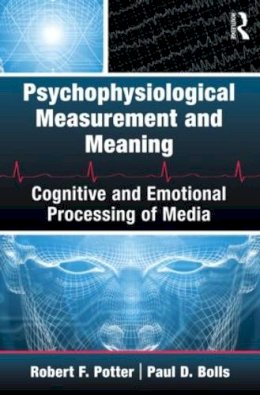
Stock image for illustration purposes only - book cover, edition or condition may vary.
Psychophysiological Measurement and Meaning
Robert F. Potter
FREE Delivery in Ireland
Description for Psychophysiological Measurement and Meaning
Paperback. Series: Routledge Communication Series. Num Pages: 310 pages, 2 black & white tables. BIC Classification: JMB. Category: (UP) Postgraduate, Research & Scholarly. Dimension: 228 x 157 x 16. Weight in Grams: 428.
This research volume serves as a comprehensive resource for psychophysiological research on media responses. It addresses the theoretical underpinnings, methodological techniques, and most recent research in this area. It goes beyond current volumes by placing the research techniques within a context of communication processes and effects as a field, and demonstrating how the real-time measurement of physiological responses enhances and complements more traditional measures of psychological effects from media.
This volume introduces readers to the theoretical assumptions of psychophysiology as well as the operational details of collecting psychophysiological data. In addition to discussing specific measures, it includes brief reviews of ... Read morerecent experiments that have used psychophysiological measures to study how the brain processes media. It will serve as a valuable reference for media researchers utilizing these methodologies, or for other researchers needing to understand the theories, history, and methods of psychophysiological research.
Show Less
Product Details
Publisher
Taylor & Francis Ltd United Kingdom
Series
Routledge Communication Series
Place of Publication
London, United Kingdom
Shipping Time
Usually ships in 15 to 20 working days
About Robert F. Potter
Robert F. Potter (Ph.D. Indiana University) is Associate Professor of Telecommunications at Indiana University, Bloomington. He is a member of Core Faculty-Cognitive Science Program and Director of the Institute for Communication Research. His research focuses on the impact of auditory elements on information processing of media, psychophysiological measures as indicators of cognitive and emotional responses to media, and the concept ... Read moreof advertising clutter and its influence on information processing. Additional information about Potter’s work can be found at www.theaudioprof.com. Paul D. Bolls (Ph.D. Indiana University) is co-director of the PRIME Lab and an associate professor of strategic communication at the Missouri School of Journalism. He conducts media psychophysiology research with a specific focus on examining mental processing of public health messages. He has been involved in building and running media psychophysiology labs for the past 15 years, having worked in labs at Indiana University, University of Missouri, and Washington State University. Show Less
Reviews for Psychophysiological Measurement and Meaning
'In addition to its compelling structure, the authors work to make the material highly approachable, both through thorough explanation of various physiological indicators as well as through a readable writing style. Indeed, the book pairs comprehensive explanation with an occasional dose of humor. In chapter 2, the authors note that one key to conducting this form of research is working ... Read moreto overcome the artificiality of the research lab by making the participant feel comfortable while researchers attach a handful of electrodes to the participant's hands, arms, and face. Likewise, it is clear that the authors worked to make the reader equally comfortable in learning about what those electrodes can tell us about message processing. As such, Psychophysiological Measurement and Meaning will likely become a useful aid in training those who wish to employ physiology in their own line of research.' R. Glenn Cummins, Journal of Broadcasting & Electronic Media 'This book is about both doing the right thing and doing it right...full of good science and practical advice for measuring and interpreting signals from the body and brain as people are exposed to media like TV programs, movies, online videos, and advertising.' Steve Genco, Intuitive Consumer Blog Show Less

